Rob’s Recipe of the Week: Maintaining Courgette Enjoyment
Every summer I treat the first courgette with excitement but as I’m sure is the case for everyone, my enthusiasm begins to wane as the summer goes on. To try and help with this myself and Rebecca have been trying out some more courgette recipes. My favourite so far is courgette fritters (sorry there’s a bit of a fritter theme at the moment!), they made for a reasonably quick work-from-home lunch.
Courgette fritters
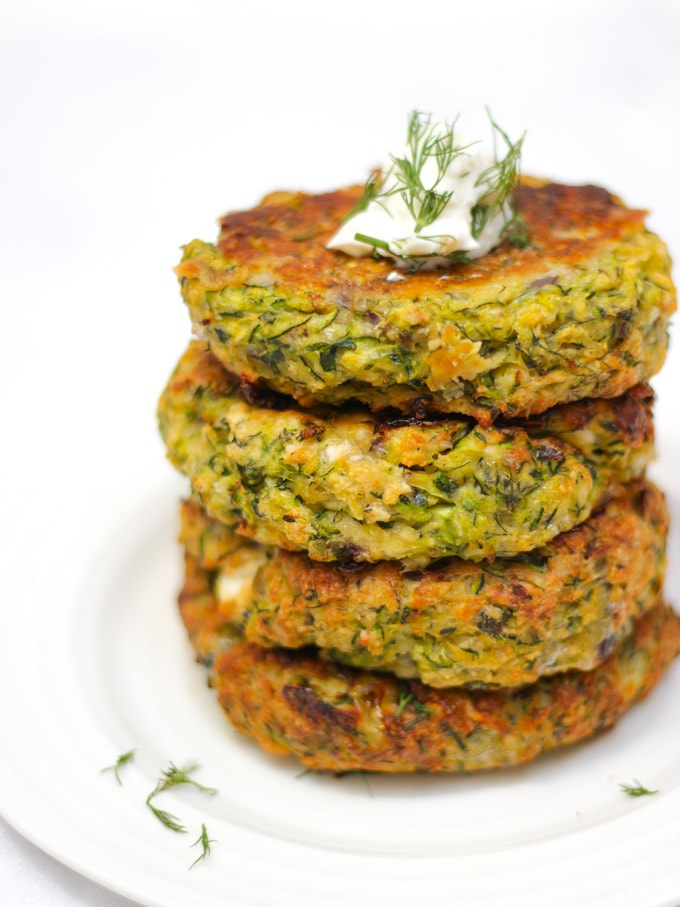
Ingredients (8 fritters):
1 kg Courgettes Grated
100 g Feta cheese Crumbled into big chunks
2 Medium free range eggs
2 Cloves Garlic Peeled and crushed
15 g Fresh dill Chopped
15 g Fresh mint Chopped
1 tsp Dried oregano
75 g Plain flour
200 g Breadcrumbs
1/2 Red onion Peeled and finely chopped
Fry light spray or Olive oil for greasing
Method:
Preheat the oven to 220C
Take your grated courgettes and over a colander, squeeze out as much of the liquid as you can. Use the colander and your hands, there will be lots!
When you’ve squeezed out the liquid, put all of your courgette fritter ingredients into a large bowl and mix well with clean hands.
Shape into 8 patties and put onto a greased (or sprayed using Fry Light) baking sheet. I got the strongest shapes by compacting a firm ball and then squash down into a disc
Bake for about 30 minutes of until browned, firm and cooked through (I fried them instead to speed things up)
From: https://www.tamingtwins.com/courgette-fritters-recipe/
Rob’s Recipe of the Week: Huauzontle fritters
This week we’re getting an unusual vegetable, Huauzontle. After a fair bit of digging it seems it’s impossible to talk about Huauzontle without mentioning the dish “Tortas de Huauzontle”, which are small battered and deep fried fritters of Huauzontle and cheese, so that has to be my recipe for this week. If this doesn’t take your fancy though it seems the best alternative is to treat it like broccoli, maybe by sauteing with onion/garlic/cumin/vinegar.
Tortas de Huauzontle
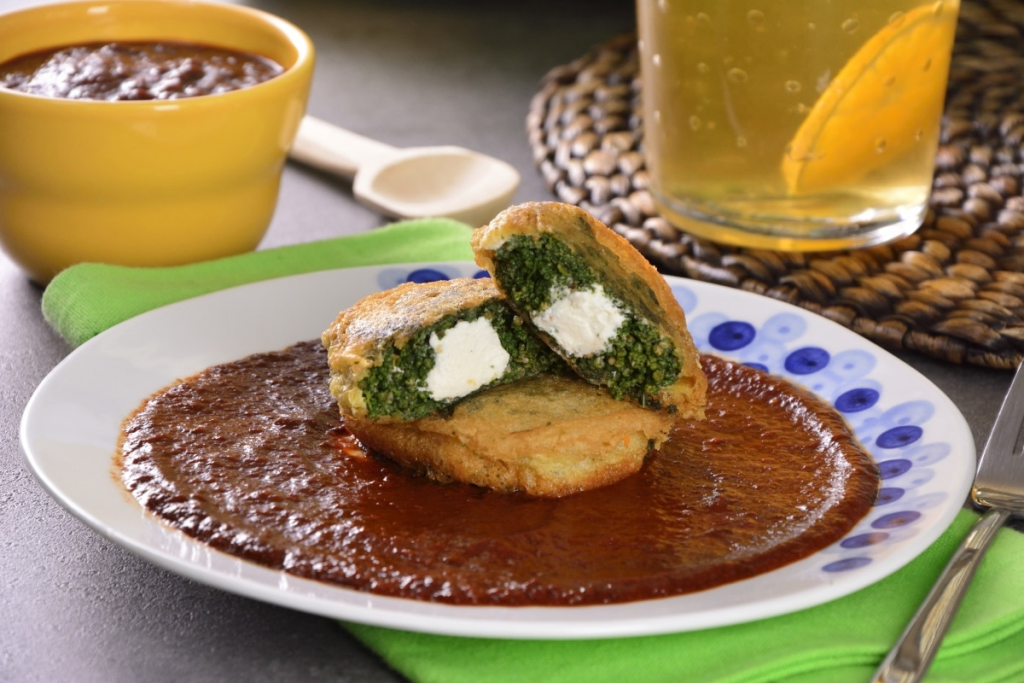
Ingredients (will need scaling according to your share):
Tortas:
1 1/2 liters Water
1 teaspoon salt
4 cups huauzontle, clean, without branches
190 grams cream cheese (or alternative)
1/2 cups flour
4 egg whites (For batter. For vegan alternative try a gram flour batter)
4 egg yolks
enough oil, to fry
Sauce:
3 pasilla chili peppers (deveined and soaked – try canalside dried chilis but beware they’re much hotter)
2 tomatoes
1/4 onions
2 cloves garlic
1/2 cups Water
2 tablespoons oil
salt
Method:
Cook huauzontles in salted water for 5-10 minutes (cook time varies wildly from recipe to recipe, cook for longer if you’re only shallow frying I think)
Place the huauzontles in a bowl of water with ice.
Remove the huauzontles and dry on a tea towel to remove moisture.
Strip everything from the bitter stalk and discard this.
Form a burger like patty in your hands by squeezing the huauzontle around a chunk of cream cheese, flouring the outside.
In a blender beat the egg whites with a pinch of salt, until peaks form
Add the yolks and beat for 1 minute more to integrate.
Dip the huauzontle pancakes in the batter.
Heat the oil over medium heat and fry 2 minutes on each side. (Make the sauce first)
For the sauce, blend the chilies, tomato, onion, garlic and water for 3 minutes.
Heat the oil over medium heat, pour the sauce, season with salt and let it cook for 15 minutes.
Serve the huauzontle pancakes bathed in pasilla sauce.
Recipe adapted from:
https://us.kiwilimon.com/recipe/main-dishes/huauzontle-pancakes-with-sauce-from-chile-pasilla
https://www.atastefortravel.ca/3408-huauzontle-puerto-escondido-mexico/#wprm-recipe-container-12833
Rebecca’s Recipe of the Week: Crushed Carrots
This is a spectacular recipe: the combination of carrots, harissa, and lemony yoghurt is inexplicably delicious. It looks particularly lovely served on a blue plate, and makes an ideal accompaniment to another Ottolenghi showstopper: his warm lentils with tahini.
Crushed Carrots with Harissa and Nuts
Serves 4
Ingredients
1 tablespoon olive oil, plus extra to finish
1 tablespoon butter
1kg carrots, peeled and sliced 2cm chunks
200ml water
grated zest of 1 orange
1 clove garlic, crushed
2 teaspoons harissa paste, or to taste
grated zest of 1 lemon divided into two portions
1 tablespoon lemon juice
150g Greek yogurt
25g shelled unsalted pistachios or cashews, coarsely chopped
Salt and black pepper
Instructions
Place the olive oil and butter in a sauté pan over medium-high heat. Add the carrots and sauté for 6 minutes, stirring often, until they’re soft and take on colour. Add the water, reduce the heat to medium-low, cover the pan, and cook for another 25 minutes, until carrots are completely soft and perhaps a little caramelised, and there is hardly any liquid left.
Transfer the carrots to a food processor, add 3⁄4 teaspoon salt, and blitz to form a coarse paste. Leave to cool, then add orange zest, garlic, harissa, one portion of the lemon zest and the black pepper to taste. Stir to combine.
Mix the yogurt, lemon juice, remaining lemon zest, and 1⁄4 teaspoon salt.
Spread the yogurt mixture on a blue serving platter and spoon the carrots on top. Sprinkle with nuts, drizzle with a little olive oil, and serve.
Recipe adapted from Yotam Ottolenghi, Plenty More (2014).
Rebecca’s Recipe of the Week: Smashed Cucumber Salad
This is an ideal recipe when you have 4 or 5 cucumbers looking at you from the bottom of your veg drawer. Smashing the cucumbers, which is apparently a classic Chinese recipe technique, changes the texture by making them more absorbent so they really soak up the dressing. It’s refreshing, easy, and makes an excellent accompaniment to an Asian-style noodle dish, such as this one for sesame noodles with smashed courgettes by Meera Sodha. (By the way, I served the noodle dish warm, which worked just fine.)
Chinese Smashed Cucumbers with Sesame Oil and Garlic
Serves 4 as a side dish
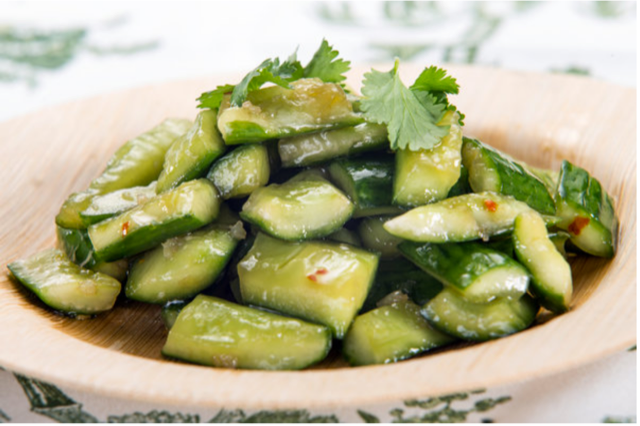
Ingredients
4 cucumbers
Salt
Sugar
1½ tablespoons rice vinegar
2 teaspoons sesame oil
2 teaspoons soya sauce
2 garlic cloves, grated
½ -1 Canalside chile, minced (to taste)
Small handful fresh coriander, chopped, for garnish
1 tablespoon toasted sesame seeds, for garnish
Preparation
Top and tail the cucumbers, and cut lengthwise into 4 long strips. Cut each strip into bite-sized pieces.
Using a rolling pin or (this is the less messy option) the side of a large knife, crush the cucumber pieces so that the skin begins to crack and the insides break down, releasing some of the seeds.
Place the crushed cucumber pieces in a colander and toss with a big pinch of salt and another of sugar. Fill a plastic bag with ice and place this on top of the cucumbers pieces, to weigh them down and at the same time chill them a bit. Leave for anywhere from 15 minutes to 4 hours.
Meanwhile, make the dressing: mix 1 teaspoon salt, 2 teaspoons sugar, and the rice vinegar. Stir until the salt and sugar have dissolved and then add the sesame oil and soya sauce.
When you are ready to serve, shake the cucumbers to drain off any remaining liquid and transfer to a beautiful flat plate. Toss with about half the dressing, and then add the garlic and as much chile as you like. Toss again, and then add more dressing to taste, until you’re pleased with the ensemble. Serve, garnished with fresh coriander and toasted sesame seeds.
Recipe adapted from New York Times Recipes.
Rebecca’s Recipe of the Week: A Very Elaborate Borscht
In case you have a little time on your hands just now, here is an excellent use of a few hours. The result is the best borscht I, at least, have ever tasted. Alissa Timoshkina, whose recipe this is, notes that if you can make the broth 24 hours in advance, ‘you will be rewarded with an even better tasting soup, but a few hours of resting will also do the trick’.
For the red cabbage sauerkraut, I recommend you get in touch with Canalside member Erica Moody, who makes superb sauerkrauts of all sorts.
Borscht
Serves 4
Ingredients
unrefined sunflower oil, for frying and roasting
1 large onion, finely diced
1 carrot, peeled and grated
6 raw beetroots
2 red peppers
2 tablespoons tomato purée
2 litres cold water
2 bay leaves
1 tablespoon black peppercorns
1 tablespoon coriander seeds
1 tablespoon fennel seeds
4 garlic cloves, peeled
bunch of dill
small bunch of flat leaf parsley
2 garlic cloves, grated
500g red cabbage sauerkraut
2 tablespoons pomegranate molasses
1 red onion
1 tablespoon brown sugar
400g can red kidney beans
2 teaspoons smoked paprika
4 tablespoons soured cream
salt
Preparation
Heat up a tablespoon of sunflower oil in a large pan and fry the onion and carrot for about 8 minutes until golden. Meanwhile, peel and grate 2 of the beetroots and core, deseed and thinly slice 1 red pepper. Add the vegetables to the pan together with the tomato purée and a splash of water. Season with salt to taste and fry for a further 5–8 minutes.
Top with the measured cold water, add the bay leaves along with the peppercorns and all the seeds, whole garlic cloves and half the bunches of dill and parsley. Season with a tablespoon of salt and bring to the boil. Reduce the heat, add the grated garlic and half the sauerkraut with its brine and simmer, covered, over a low heat for 40 minutes–1 hour.
Turn off the heat and let the borscht rest for another hour, while you prepare the rest of the elements.
So far, so good, but here is where the recipe starts to deviate from the norm quite a lot: to prepare the vegetables that will grace the plate and also add extra flavour and texture to the soup, you will need to do a bit of roasting.
Start by preheating the oven to 160°C fan/Gas Mark 4. Peel the remaining 4 beetroots, cut into wedges and dress with oil, salt and the pomegranate molasses. Peel the red onion, cut into wedges and season with salt and the brown sugar to bring out their sweetness and promote caramelization. Place on a roasting tray with the beetroot and roast together for 30 minutes. Drain the kidney beans, then dress them with salt, oil and the smoked paprika. Core and deseed the remaining red pepper, then cut into thin strips and dress with salt and oil. Roast the beans and pepper together, as they will need only 10–15 minutes.
When ready to serve, strain the broth through a sieve or a muslin cloth, discarding the solids. All we need is that rich broth! Reheat again if necessary. Next, create layers of texture and flavour in each bowl by adding a heaped tablespoon of the remaining sauerkraut to each, as well as a handful of roasted beetroot, onion, kidney beans and red pepper. Top each bowl with the hot broth and add a dollop of soured cream and a generous sprinkle of the remaining dill and parsley, chopped. The intensity of the flavours and textures of this dish is beyond words, while the look of the bowl will seduce the eye without a doubt.
Recipe from Alissa Timoshkina, Salt & Time: Recipes from a Russian Kitchen (2019).
Rebecca’s Recipe of the Week: Spare Squash
I managed to accumulate several Canalside squash in my fridge over the last fortnight. I was going to make them into a cake (and if that’s what you’d like I commend to you this recipe for brown butter spice bread.) Instead I ended up making this easy, flavourful roast squash with a spicy, umami-rich chile oil. The chile oil complements the unctuousness of the squash and is absolutely delicious. Serve it with steamed greens for a colourful and satisfying dinner.
Whole Roast Squash with Black Bean and Chile Oil
Serves 2
Ingredients
2 Canalside squash shares (not that the size is super important)
2 tablespoons rapeseed oil
3 cloves garlic, peeled and sliced fine
1 tablespoon salted black beans, rinsed
a fragment of a Canalside chile, or 1-2 teaspoons chile flakes
1 tablespoon soya sauce
1 teaspoon caster sugar
Preparation
Heat your oven to 180C. Remove the seeds from the squash.1 Put the de-seeded squash on a baking sheet and roast it until it is tender and golden, 45-75 minutes. Remove from the oven.
Meanwhile, make the black bean and chile oil. Over a low flame, heat the rapeseed oil in a small saucepan for 1 minute. Add the garlic and fry gently for 1-2 minutes, until the garlic is golden brown and a little sticky. Remove the pan from the heat and add the black beans. Return to the heat and add the chile, soya sauce, sugar and 2 tablespoons of water. Heat for about 20 seconds, stirring constantly. Remove from the heat and let cool.
When the squash is cooked, you can either cut it into slices and serve warm, or let it cool before slicing. In either case drizzle the black bean and chile oil over the top and serve with a side of steamed green vegetables.
Recipe adapted from Meera Sodha, East (2019).
Rebecca’s Recipe of the Week: David Lebovitz’s Radish Leaf Soup
Freakily, last week two different people, from two different continents, sent me this recipe for radish leaf soup. I feel that is a sign that the recipe must now be shared with everyone at Canalside, even though, lacking a potato, I have not yet had a chance to make it myself. Let me know how you get on with the peppery, leafy radish leaves that are doubtless still sitting in your fridge from last week. It looks delicious—please note especially the suggestion of topping your soup with ‘pumpkin seeds, sliced radishes, crème fraîche, sour cream, olive oil, freshly cracked black or a pinch of red pepper powder, scallions, edible flowers, fresh herbs, a dollop of pesto, or a dribble of pumpkin seed oil’.
Radish Leaf Soup
6-8 servings

I (that’s David Lebovitz) strongly suggest you use radish leaves that are unsprayed or organic, and wash them well to make sure all grit has been removed. If you don’t have enough radish leaves, feel free to make half the recipe, or bulk it up with lettuce or another mild green. Something like spinach, kale, or Swiss chard will overtake the flavor of the radish leaves (although it’s not the end of the world if you’re trying to use up odds and ends of various greens), but you could use arugula in addition to the radish leaves, or something similar. I don’t peel the potatoes but you are welcome to. If using commercial chicken stock, cut the salt in half and add more, to taste. If you don’t have chicken stock, water or vegetable stock works fine. I added a touch of heavy cream, which smoothed things out nicely and gives the soup a subtle richness, but offered a few alternatives. You could use more, or use regular milk (cow or plant-based), or leave it out. Possible garnishes are, but are not limited to, pumpkin seeds, sliced radishes, crème fraîche, sour cream, olive oil, freshly cracked black or a pinch of red pepper powder, scallions, edible flowers, fresh herbs, a dollop of pesto, or a dribble of pumpkin seed oil.
Ingredients
2 tablespoons butter, salted or unsalted
2 tablespoons olive oil
1 large onion, peeled and diced, or 2 leeks, cleaned and sliced
1 1/2 teaspoons kosher or sea salt
freshly ground black pepper (I used a total of about 1 teaspoon of pepper)
4 cloves garlic, peeled and sliced
2 medium potatoes, washed and diced, (12-16oz, 340-450g)
2 cups (500ml) water
12 cups (lightly packed) fresh radish leaves, rinsed very well (9 oz, 270g)
3 cups (750ml) chicken stock
1 tablespoon Dijon mustard
1/8 teaspoon cayenne pepper
1/2 cup (125ml) heavy cream, sour cream, mascarpone, or creme fraiche
Preparation
- Heat the butter and olive oil in a soup pot or Dutch oven over medium-high heat. Add the onions and cook, stirring frequently, seasoning them with the salt and pepper, until soft and translucent, about 5 minutes. Add the garlic and stir for a minute or two, to help them release their aroma.
- Add the potatoes and 2 cups of water to the pot. Cover, bring to a boil then reduce the heat to a steady simmer and cook until the potatoes are tender when poked with the tip of a sharp paring knife, about 10 to 15 minutes.
- Add the radish leaves and stock. Cover, bring to a boil, then reduce the heat and simmer just until the radish leaves are wilted and cooked through. Remove from heat.
- If using an immersion blender, add the cream, mustard, cayenne, and cream to the pot and puree until smooth. If using a standard blender, let the soup cool until tepid then puree the soup with the cream and mustard. (Never fill a blender more than half full with hot liquid as it can blow off the lid and cause injuries.) Rewarm the soup and serve with any of the suggested garnishes.
Recipe from David Lebovitz, https://www.davidlebovitz.com/radish-leaf-soup-recipe-soupe-fan-radis-recette/.
Rob’s Recipe of the Week: Spring Dal
We’re getting some huge spring greens at the moment and I’ve discovered a few new recipes involving them as a result. I make Dhal fairly regularly but rarely follow a recipe. This one is a really good introduction though, I was quite amazed at how rich it tasted and I’m really not sure what the difference was to my usual attempts! Make sure you cook until the lentils are soft, I’m often too impatient.
Spring Green and Coconut Dal

Ingredients (Serves two)
1 tbsp coconut oil
1 onion, finely sliced
1 large or 2 small garlic cloves, finely chopped, grated or crushed
4cm piece of fresh ginger, peeled and finely grated
1 red chilli, finely sliced
1 tsp black mustard seeds
¼ tsp ground turmeric
1 x 400ml tin coconut milk
100g yellow mung dal lentils, rinsed in a sieve (I used red lentils)
1 tsp coriander seeds, toasted and ground
1 tsp cumin seeds, toasted and ground
200g spring or summer greens, tough ribs removed (sliced them and fired with the onion), leaves finely shredded. Feel free to go heavy on the greens I found they worked well.
handful of coriander leaves
a squeeze of lime or lemon juice
toasted coconut chips or toasted desiccated coconut, to garnish
salt
Method
Prep time: 5 min
Cooking time: 50 min
Melt the coconut oil in a large pan. Add the onion and fry on a low heat for 10 minutes, stirring occasionally.
Turn up the heat a little and add the garlic, ginger, chilli, mustard seeds and turmeric. Stir for about 1 minute, until you hear the mustard seeds start to pop. Stir the coconut milk in the can then pour into the pan with the lentils and ground coriander and cumin. Fill the coconut milk can half full with water and add that too.
Bring up to the boil, reduce the heat and simmer for about 15 minutes. Add the greens, stirring in small handfuls at a time, then cook for a further 5–10 minutes, until the lentils are tender and the greens wilted. Keep an eye on the liquid and add more water if needed.
Season the dal with salt, stir in the fresh coriander and add a squeeze of lime or lemon juice to taste. Serve the dal prinkled with toasted coconut and a few extra coriander leaves.
Adapted from: https://www.riverford.co.uk/recipes/spring-green-and-coconut-dal
Rob’s Recipe of the Week: A Dish Full of Pink
We’ve had a whole lot of beetroot to contend with this winter and I’m still trying to find new ways to use it. This recipe seemed very lockdown themed as I imagine a lot of people have been trying out sourdough bread for the first time. I’m not a big fan myself but combined with a beetroot gratin I can give it a chance!
Beetroot and pink peppercorn gratin
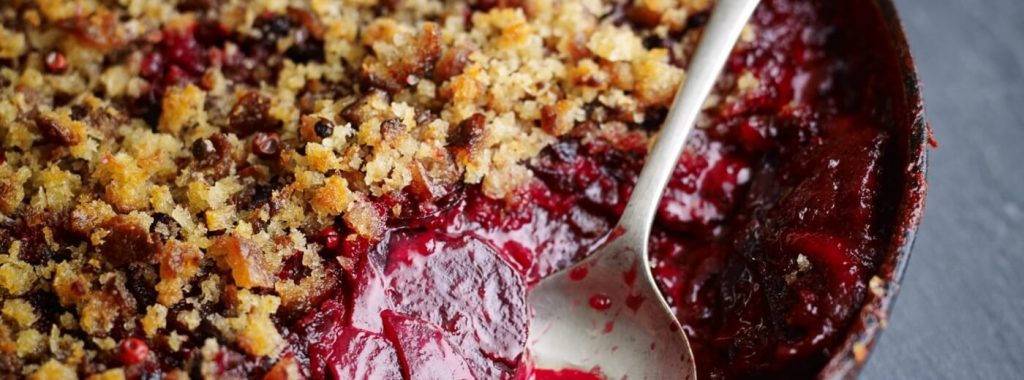
As good with roast beef for Sunday lunch as it is a smart veggie main. The pink peppercorns add an extra rosy zing, but just use normal black pepper if you can’t find them.
Serves 6 (Scale the recipe to match your share size.)
Ingredients
1.5kg beetroot, peeled
4 garlic cloves
250ml double cream
2 slices of day-old sourdough bread
40g butter, chilled, diced
Olive oil
3 tbsp finely ground pink peppercorns
Red wine vinegar
Salt and black pepper
Method:
1 Preheat the oven to 180C/350F/gas mark 4. Thinly slice the beetroot either by hand or using a mandolin.
2 Give the garlic cloves a good bash and pop them in a pan with the cream, slowly bring to the boil, simmer gently for 10 minutes and then leave to infuse for a further 10 minutes.
3 Sieve the cream on to the beetroot, pressing the garlic with the back of a spoon to extract the flavour. Season generously with salt and mix well.
4 Pack the beetroot into an ovenproof roasting dish. Cover tightly with foil. Bake for anywhere between 30-45 minutes (it will depend on the age and season of the beetroots) or until it yields easily to the tip of a knife.
5 Cut the crusts from your sourdough and blend the insides into a coarse crumb, add the cold butter and a small glug of olive oil and pulse again, as though you’re making a crumble topping.
6 Remove foil and stir in the pink peppercorns, a dash of red wine vinegar to taste and check the seasoning. Arrange in a gratin dish and sprinkle with the breadcrumbs. Bake until golden brown on top and bubbling.
Rob Andrew, Riverford Field Kitchen, https://www.riverford.co.uk/recipes/beetroot-and-pink-peppercorn-gratin
Featured in Guardian Food, 10 Best Beetroot Recipes https://www.theguardian.com/lifeandstyle/2014/may/24/10-best-beetroot-recipes
Rob’s Recipe of the Week: Lasagne with a difference
I can rarely bring myself to make lasagne but this recipe has got me interested. The question is whether the shops will actually have lasagne sheets in stock but fingers crossed!
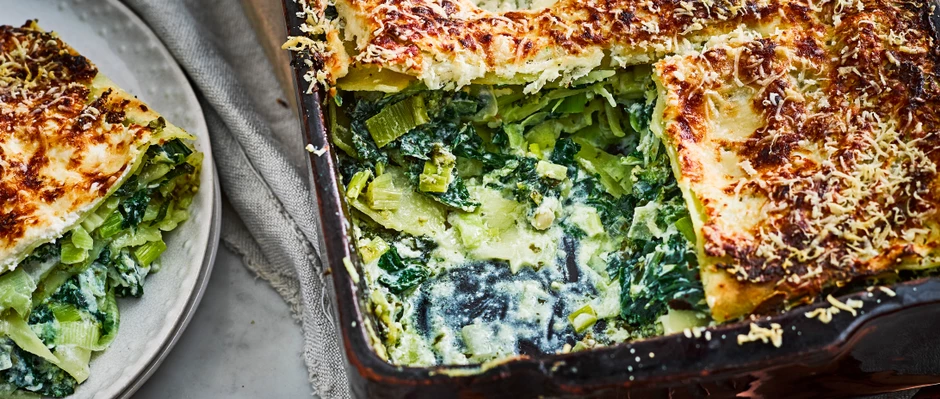
Kale, ricotta and leek lasagne
Ingredients
kale 300g, woody stems removed and leaves chopped
olive oil 1 tbsp
trimmed leeks 3 (about 400g), halved lengthways, washed and chopped
garlic 1 clove, crushed
ricotta 350g (try vegan version from https://www.bosh.tv/recipes/spicy-creamy-cannelloni)
vegetable stock 150ml
fresh pesto 4 tbsp
fresh lasagne 250g, about 8 sheets
parmesan (or veggie alternative) 30g, finely grated
Method
Heat the oven to 200C/fan 180C/gas 6. Drop the kale in boiling salted water, bring back to a simmer then cook for 5 minutes. Drain really well.
Heat the olive oil in a frying pan and add the leeks with a good pinch of salt. Cook for 8-10 minutes or until really soft.
Add the garlic to the leeks and cook for 2 minutes. Keep 4 tbsp of the ricotta aside then stir the rest into the leeks with the kale. Mix everything well then add enough vegetable stock to make it a little saucy but not watery. Take off the heat.
Put a 1/4 of the sauce in the bottom of an oiled baking dish approximately 18 x 25cm. Top with 1 tbsp pesto then 2 sheets of lasagne. Repeat 3 times, ending with lasagne.
Mix the rest of the ricotta with another splash of vegetable stock and spread over the top layer. Scatter over the parmesan and bake for 20 minutes until golden and bubbling.
From: https://www.olivemagazine.com/recipes/vegetarian/kale-ricotta-and-leek-lasagne/